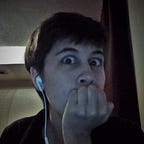Four YA Novels with Badass Girls Written by Men
A well developed character is one who has a lot of depth and displays a higher number of traits than those of, say, background characters. Developed characters demonstrate thought processes that don’t always have to do with supporting the storyline, and are consequently much more believable and relatable. Male writers have been criticized in the past for poorly representing female characters — failing to develop their physical and mental traits, and using them solely as plot devices to aid the main character. While there’s still a ways to go when it comes to the common acceptance of writing the opposite gender, there’s also been excellent progress made toward literary equality. The following men have gone past the stigmas that may come from writing female characters, as well as the supposed difficulties that many people run into when writing characters of the opposing sex. Gentlemen, if you’re looking for inspiration when it comes to well-written young ladies, look no more!
Kitty Jones from the Bartimaeus Triogy
Jonathan Stroud
When a magician brutally scarred one of Kitty’s childhood friends, she formed a vendetta against the casters of her society, pursuing a life of crime that eventually led her to aid in the destruction of a corrupted parliament. While Kitty is only vaguely mentioned in the first book, her importance to the plot and her characterization grows throughout the following two books. Kitty demonstrates empathy toward those around her and the very human struggle of balancing her morals against the morals of those she trusts. She adamantly fights a system that thrives on oppression and demonstrates excellent problem solving and adaptation skills. Throughout the storyline, Kitty gradually grows and changes her opinions of those around her, even going so far as placing her trust in the most unlikely of people. Her growth and development throughout the trilogy are incredible, following an otherwise plain but determined young girl as she discovers exactly what she wants her place in the world to be. While any other young girl would be unremarkable, Jonathan Stroud chose Kitty to rise above the others in London and question why their society seemingly needs to function as it does.
Leisel Memminger from the Book Thief
Markus Zusak
When Leisel undergoes the traumatic loss of her brother and has to move in with a new family at only nine years old, she’s immediately forced to face more struggles than most do in a lifetime. Leisel pays attention to the world around her and, after being taught to read, develops a strong passion for literature. While she’s unable to do much against it, the young girl is clearly aware of the devastation surrounding her and her family and the abuse of power demonstrated by her leaders. Throughout the story, Leisel comes to realize that while she cannot stop Hitler’s regime from harming those around her, she can bring light to the world through her reading and writing. Leisel responds empathetically to other characters and develops herself from them. She goes from an ornery scrapper child to one caught in the disarray of Hitler-controlled Germany. Despite the fact that Markus Zusak has never experienced the life of a young girl, she still exhibits incredibly human reactions to the world around her, and continues to grow and adapt with it.
Coraline
Neil Gaiman
Coraline starts off as a frustrated young girl going through the stress of a new move. From the beginning, she’s incredibly unlikeable, with a short fuse and a temperament that most would consider bratty. When the opportunity to swap out her dreary life for a new one presents itself, she immediately succumbs to it. Over time, she becomes aware of the dangers that this new life holds, and during a daunting rescue of her loved ones and others who had been trapped by these dangers, she comes to further appreciate what she has and what she earns. From the beginning, Coraline clearly possesses higher thinking processes — able to solve puzzles and satiate her curiosity while still pursuing childish and girlish fancies. Throughout the story, she expresses to other characters a reluctance to roll over and accept what she believes is incorrect (“My name isn’t Caroline!” being an excellent example from the get-go). Neil Gaiman created Coraline to know what she wanted and always pursue it, and Coraline sets an excellent example for girls everywhere of what it means to be a kid and what young girls can be capable of.
Sansa Stark from the Game of Thrones series
George R.R. Martin
Despite the fact that Sansa has been educated in the art of being a noblewoman, trauma came early for the young girl when she witnessed the breaking up of her family, the execution of her father, and underwent an arranged marriage to a psychopath. While Sansa understands there’s little she can do to combat the pain she undergoes, she expresses a desire to keep fighting it in any way she can. As time goes on, she begins to realize she’s being used as a tool to everyone around her, and her development as both a woman and a political authority starts allowing her to make broader decisions. While they’re as fallible as any inexperienced person thrown into politics can be, she remains responsive to the circumstances she keep being put in to, and never stops trying to change things for the better. George R.R. Martin created a young character who’s forced to undergo more pain than most could handle, and allows her character to keep developing with the plotline and change from the delicate little girl she once was, to a more cunning and experienced young woman she leaves off at at the end of the series.
